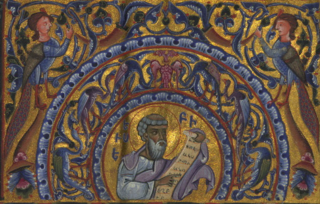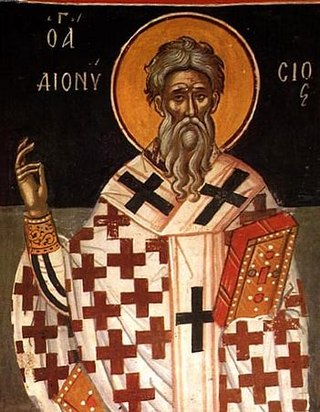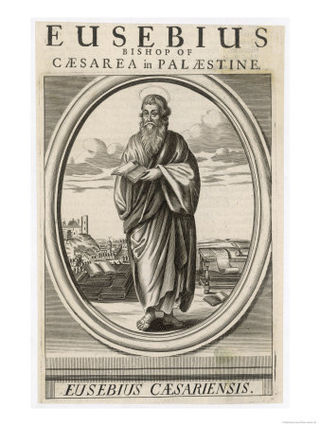
Eusebius of Caesarea, also known as Eusebius Pamphilus, was a Greek historian of Christianity, exegete, and Christian polemicist. In about AD 314 he became the bishop of Caesarea Maritima in the Roman province of Syria Palaestina. Together with Pamphilus, he was a scholar of the biblical canon and is regarded as one of the most learned Christians during late antiquity. He wrote Demonstrations of the Gospel, Preparations for the Gospel and On Discrepancies between the Gospels, studies of the biblical text. As "Father of Church History", he produced the Ecclesiastical History, On the Life of Pamphilus, the Chronicle and On the Martyrs. He also produced a biographical work on Constantine the Great, the first Christian Roman emperor, who was augustus between AD 306 and AD 337.
Agapius was a Christian martyr killed at Caesarea in AD 306. He is recognized as a saint by the Catholic Church. His martyrdom is recorded by Eusebius of Caesarea in his work The Martyrs of Palestine.
Saint Pamphilus, was a presbyter of Caesarea and chief among the biblical scholars of his generation. He was the friend and teacher of Eusebius of Caesarea, who recorded details of his career in a three-book Vita that has been lost.

Dionysius the Great was the 14th Pope and Patriarch of Alexandria from 28 December 248 until his death on 22 March 264. Most information known about him comes from his large surviving correspondence. Only one original letter survives to this day; the remaining letters are excerpted in the works of Eusebius.

During the reign of the Roman Emperor Constantine the Great (AD 306–337), Christianity began to transition to the dominant religion of the Roman Empire. Historians remain uncertain about Constantine's reasons for favoring Christianity, and theologians and historians have often argued about which form of early Christianity he subscribed to. There is no consensus among scholars as to whether he adopted his mother Helena's Christianity in his youth, or, as claimed by Eusebius of Caesarea, encouraged her to convert to the faith he had adopted.

The Diocletianic or Great Persecution was the last and most severe persecution of Christians in the Roman Empire. In 303, the emperors Diocletian, Maximian, Galerius, and Constantius issued a series of edicts rescinding Christians' legal rights and demanding that they comply with traditional religious practices. Later edicts targeted the clergy and demanded universal sacrifice, ordering all inhabitants to sacrifice to the gods. The persecution varied in intensity across the empire—weakest in Gaul and Britain, where only the first edict was applied, and strongest in the Eastern provinces. Persecutory laws were nullified by different emperors at different times, but Constantine and Licinius' Edict of Milan in 313 has traditionally marked the end of the persecution.

Alexander of Jerusalem was a third century bishop who is venerated as a martyr and saint by the Eastern Orthodox Church, Oriental Orthodox churches, and the Roman Catholic Church. He died during the persecution of Emperor Decius.
Saints Leontius, Hypatius and Theodolus were Roman soldiers who, according to Christian tradition, were martyred for their faith.

Romanus of Caesarea is venerated as a martyr. A deacon of Caesarea, he was martyred at Antioch.

The persecution in Lyon in AD 177 was a legendary persecution of Christians in Lugdunum, Roman Gaul, during the reign of Marcus Aurelius. As there is no coeval account of this persecution the earliest source is a letter preserved in Eusebius's Ecclesiastical History, book 5, chapter 1, written 150 years later in palestine. Gregory of Tours describes the persecution in the 6th century in De Gloria martyrum.

Saint Julia of Corsica, also known as Saint Julia of Carthage, and more rarely Saint Julia of Nonza, was a virgin martyr who is venerated as a Christian saint. The date of her death is most probably on or after AD 439. She and Saint Devota are the patron saints of Corsica in the Catholic Church. Saint Julia was declared a patroness of Corsica by the Church on 5 August 1809; Saint Devota, on 14 March 1820. Both were martyred in pre-Christian Corsica under Roman rule. Julia's feast day is 23 May in the Western liturgical calendar and 16 July in the East.
Elias and four companions, Daniel, Isaiah, Jeremiah, and Samuel were Egyptian martyrs. Their feast day is February 16.

The persecution of Christians in the Roman Empire occurred, sporadically and usually locally, throughout the Roman Empire, beginning in the 1st century AD and ending in the 4th century. Originally a polytheistic empire in the traditions of Roman paganism and the Hellenistic religion, as Christianity spread through the empire, it came into ideological conflict with the imperial cult of ancient Rome. Pagan practices such as making sacrifices to the deified emperors or other gods were abhorrent to Christians as their beliefs prohibited idolatry. The state and other members of civic society punished Christians for treason, various rumored crimes, illegal assembly, and for introducing an alien cult that led to Roman apostasy.
Basilides and Potamiaena were Christian martyrs now venerated as saints. Both died in Alexandria during the persecutions under Septimius Severus.
Saint Aedesius of Alexandria was an early Christian martyred under Galerius Maximianus. He was the brother of Saint Aphian. According to the martyrology, he publicly rebuked a judge who had been forcing Christian virgins to work in brothels in order to break them of their faith, so he was tortured and drowned.
Agapius of Palestine was a Christian martyr from Gaza, beheaded along with seven others by order of Urban, governor of Palestine, in the year 303 or 304 under the Great Persecution of Diocletian. Eusebius records that Timolaus of Pontus, Dionysius from Tripolis in Phœnicia, Romulus, said to have been sub-deacon of the parish of Diospolis, Plæsius of Egypt, and two men named Alexander, one from Gaza and the other from Gazahad. These six young men bound themselves and surrendered to Urban in the hopes of becoming martyrs. They openly professed their Christianity and said that their faith made them unafraid of the wild animals of the arena. Urban had them put into prison. A few days later they were joined by two others, one a certain Dionysius, and the other Agapius, who is said to have been tortured in the past for his faith. All eight were beheaded in Caesarea Maritima on the same day.
Marinus of Caesarea was a Roman soldier and a Christian martyr.

Saint Theodosia of Tyre, according to the historian of the early Christian church Eusebius, was a seventeen-year-old girl who deliberately sought to be executed as a martyr to Christianity in the city of Caesarea in 307 AD. She was tortured, urged to reject Christianity, and, when she refused, thrown into the sea. She is commemorated on April 2.

Saint Timolaus and five companions, according to the historian of the early Christian church Eusebius in his Martyrs of Palestine, were young men who, having heard that the Roman authorities in Caesarea, Palestine, in 303 AD, had condemned a number of Christians to die by being thrown to wild beasts in the public arena, came before the governor of their own volition with their hands tied behind their backs and demanded to join their fellow Christians in that martyrdom. They were not however thrown to wild beasts but decapitated along with two other men who were already in prison.

On the Martyrs of Palestine is a work by church historian and Bishop of Caesarea, Eusebius, relating the persecution of Christians in Caesarea under Roman Emperor Diocletian. The work survives in two forms, a shorter recension which formed part of his Ecclesiastical History, and a longer version, discovered only in 1866. Eusebius was present in Caesarea at the time of the persecutions he recounts.











